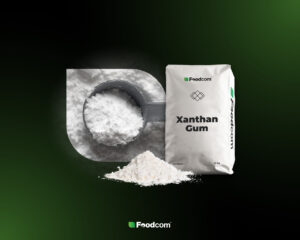- Xanthan Gum is a polysaccharide composed of glucose, mannose and glucuronic acid.
- It is used as a thickener, emulsifier and stabilizer.
- Xanthan Gum is used in food, cosmetic, pharmaceutical and petroleum industries.
- The market for Xanthan Gum is growing due to the increasing popularity of vegetarian, vegan and gluten-free products in which it acts as a texturizer.
What is Xanthan Gum?
Xanthan Gum is a polysaccharide composed of glucose, mannose and glucuronic acid. It is produced from corn, wheat or cane sugar, but can also be obtained from lactose. The process involves fermentation of simple sugars using Xanthomonas campestris bacteria. Xanthan Gum is obtained, which is then purified to remove foreign particles and other microorganisms. The product is then dried and milled.
Xanthan Gum is often used as a food additive – E415 – because of its many texture-altering properties. Want to learn more about this unique substance? Read on!
Xanthan Gum – properties
Xanthan Gum is a free-flowing white or yellowish powder with no foreign odor, characterized by high solubility in water. It functions in a wide pH range. It has the ability to absorb moisture from the air, that is, it is hygroscopic. It dissolves well in both hot and cold water, as well as other liquids. In an aqueous environment, it swells.
Xanthan Gum is widely used in industry for its wide range of texture-modifying properties. It is used as a thickener, texturizer and stabilizer. It is also an emulsifier that increases the stability of emulsions.
Xanthan Gum – applications
Xanthan Gum is mainly used in the food industry. As E415, it is a thickener, stabilizer and emulsifier. It can be used as a substitute for Gelatin, in products for vegetarians and vegans. It is also used in baking and confectionery. In addition, Xanthan Gum is a thickener that can replace fat, so it is used in low-calorie foods.
Another important use of Xanthan Gum is in the oil and gas industry. It is commonly used in large quantities as a drilling fluid to maximize oil recovery.
In the cosmetics industry, Xanthan Gum is used as a stabilizer and emulsifier in toothpaste, gels, creams and lotions. It improves viscosity and helps maintain the consistency of products.
In the pharmaceutical industry, Xanthan Gum is used as a thickening agent and as a component of protective formulations. It is also used to delay the release of the active ingredient from a tablet. In addition, Xanthan Gum is used to make artificial saliva, which is used to treat people with Sjogren’s syndrome which is insufficient salivary secretion.
In addition, Xanthan Gum is used as an ingredient in paints, textile dyes, fungicides, fertilizers and adhesives.
Food Grade Xanthan Gum
In the food industry, Xanthan Gum is an ingredient in many products. First, it has a wide range of applications because it has properties that can be used in both acidic and alkaline environments. In addition, foods that contain it have the right texture, are more resistant to enzymes that alter the properties of products, as well as to temperature differences, such as heating, freezing and thawing again.
Xanthan Gum stabilizes emulsions, suspensions, and aqueous dispersions and prevents products from thickening during cooling, so they flow smoothly in products such as salad dressings, condiments, and syrups. It also enables the suspension of spice particles and flavor enhancers in fat-free dressings marketed as “light” or “reduced-calorie” products.
Its stability in low pH environments makes it an ideal ingredient for various sauces and dips. In the baking and confectionery industries, Xanthan Gum improves the fluffiness of baked goods, provides moisture retention and increases dough volume. It also delays the blackening process of bread by inhibiting starch retrogradation. Many frozen food products contain Xanthan Gum because it provides excellent stability at very low temperatures.
Xanthan Gum is also used in gluten-free products to improve texture and suspension. In vegan products, Xanthan Gum provides the viscosity that would normally be achieved by using eggs.
Xanthan Gum in cosmetics
In the cosmetics industry, Xanthan Gum is a popular texturizing agent. It can be used in concentrations ranging from 0.01% to 10%. It is widely used due to its stability in acidic environments and at low temperatures, after freezing and thawing. Xanthan Gum enables the combination of different cosmetic ingredients by changing the interfacial tension, which promotes the formation of mixtures between immiscible liquids. It also supports the emulsification process and increases the stability and shelf life of emulsions and gives liquid formulations a gel-like consistency.
It is used to thicken and as an emulsifier in cosmetics, especially in the production of cosmetic gels. Xanthan Gum is found in: Cleansing products, emulsions, lotions, hair care products and make-up removal products.
Want to learn more about the ingredients used in the manufacture of cosmetics? Be sure to check out our article!
Xanthan Gum market outlook
Xanthan Gum is becoming increasingly popular, which is influenced by the following market trends. In recent years, the popularity of vegetarian and vegan diets has increased. Since xanthan gum is a vegetable equivalent to gelatin and can serve as an egg substitute, this has a major impact on its market growth. Due to growing health awareness among consumers, there has also been an increase in demand for gluten-free products, in which Xanthan Gum is often used as a texturizer.
When analyzing the market for Xanthan Gum, it is important to note that demand for it is seasonal. For example, we observe increased demand after the fruit harvest, which is due to the more intensive production of jams, for which this raw material is used.
Why Foodcom?
Our great team of Sales Support will help our Traders conduct the contract and business deals in a smooth and efficient way to ensure the best quality service to all our Business Partners. Our logistics team will take care of transportation and the financial department will be responsible for all matters connected with the financial part of the deal. Do not hesitate! Contact us.









